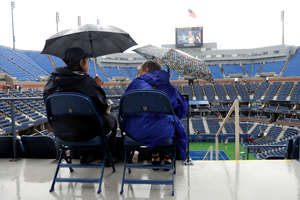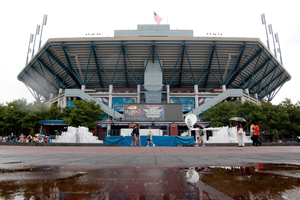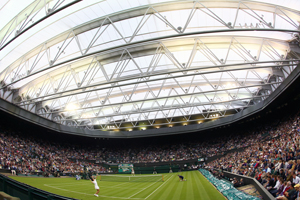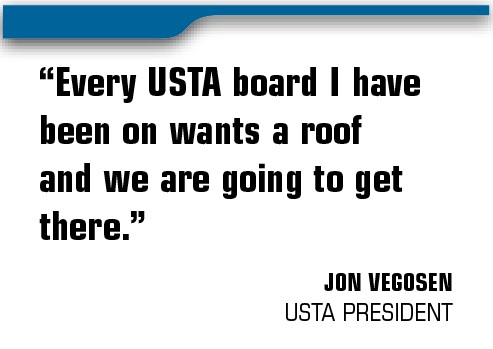The U.S. Tennis Association is in advanced discussions with structural engineers about ripping out much of the upper bowl of Arthur Ashe Stadium and rebuilding it with lighter-weight materials that could support a roof, the organization’s top two officials said.
The absence of a roof on the 15-year-old structure has bedeviled the U.S. Open Tennis Championships the last four years, with rain pushing the men’s final from Sunday to Monday, and the women’s final in different years into a Sunday from Saturday, creating havoc for television and on-site spectators.
 |
Rain has plagued the U.S. Open in recent years, keeping on-site spectators and television viewers waiting.
Photo by:Getty Images |
The idea of building a roof has been discussed for years, and the USTA has suffered withering criticism for not having one in place. When the group announced in June a half-billion-dollar redevelopment plan that did not include adding a roof, the media focused on what the effort did not have rather than what it did.
“They clearly had fallen behind in quality in so many ways, and we were somewhat taken aback they had not gone the whole hog and put a roof on the whole thing,” said Neil Harman, a tennis correspondent for the London Times who is writing a book on the 2012 tennis season.
The USTA plans to press on with its redevelopment plan while it studies the roof option. But in addition to the engineering obstacles posed by a roof, the USTA must overcome organizational obstacles that have put such a project on hold in the past.
Without a roof, the Open would stand out from the three other Grand Slams. The Australian Open already has a roof over each of its top two stadiums, with plans for one over a third venue. Wimbledon has one roof and has talked about a second. The French Open announced redevelopment plans that envision a roof by 2016.
The USTA Billie Jean King National Tennis Center faces a challenge because it sits on swampy ground. Arthur Ashe
Stadium, at least as currently constructed, would sink under the added weight of a roof.
Over the last decade the USTA and its master planner, Rossetti, have considered several options, including building a new stadium or erecting a structure around Ashe Stadium that itself would hold up the roof.
In 2008, Arlen Kantarian, then the USTA’s chief executive of professional tennis, strode into the media room during an Open rain delay and, responding to a reporter’s question about a roof, replied it was a “question of when and not if.” That was the first time the USTA had gone that far in support of a roof.
But when Kantarian left the organization later that year, so apparently did the will to build a covering. Over the next few years, USTA executives said a roof would be too expensive to build and would detract from spending money on grassroots tennis. The USTA’s mission is to promote tennis play.
Now once again, at least publicly, that attitude appears to be shifting.
“Every USTA board I have been on wants a roof and we are going to get there,” said Jon Vegosen, the USTA’s current president, who is in the last few months of his two-year term.
Gordon Smith, the USTA’s executive director, said: “We are coordinating with a number of external structural engineers, people who have the materials, and they are in the coordinating role with many, many other entities who would frankly love to have the feather in their cap of solving this very difficult technological problem.”
 |
The idea under consideration would involve removing most of the stadium’s upper bowl and replacing it with lighter materials and a roof.
Photo by: Getty Images |
Under the proposal, the shell of Arthur Ashe Stadium’s upper bowl would remain, but the seats, and the concrete that attaches them to the shell, would come out. The seats and the attached materials account for about 40 to 50 percent of the upper bowl’s weight. The idea behind the current proposal is that lighter-weight replacement seats, plus a roof, would weigh the same as the portion of the stadium that would be replaced.
Vegosen and Smith declined to say if a decision is near, saying only that the technological progress in the area is rapid and had speeded the possibilities greatly. No cost estimates have been released.
“We are a lot closer than a year ago,” Vegosen said.
If that moment does come, Smith said, it will not affect the earlier announced plans to redo the tennis complex. That plan includes tearing down the current No. 2 stadium, moving the No. 3 stadium, and building a viewing platform adjacent to the practice courts.
How to pay for it
The USTA plans to tap the Open’s operating profit of more than $100 million annually to cover the initial costs of improvements. But signaling that the USTA does not want the redevelopment project to reduce aid to grassroots tennis, Smith said the organization would take on a decent amount of debt to fund the renovations.
He ruled out the sale of personal seat licenses to fund the redevelopment. “The cost will not be done on the back of our ticket holders,” he said.
Wimbledon has funded the bulk of its renovations over the years with debentures, which are PSLs that expire every five years.
Noting the difficulties the New York Jets encountered selling their cache of PSLs at MetLife Stadium, Smith said that the Open’s ticket prices are already high enough.
For sure, upgrades are needed. Last year the USTA shut down the No. 2 court, Louis Armstrong Stadium, midway
 |
The U.S. Open is playing catch-up with other Grand Slams that already feature roofs, including Wimbledon (above) and the Australian Open.
Photo by: Getty Images |
through the tournament when water bubbled up from beneath the court during a match. The tournament dispatched workers to sop up the water with towels and then sent the players back on court, infuriating one of them, Andy Roddick. USTA cameras caught his furious exchange with tournament referee Brian Earley, broadcasting the argument into the media room. Earley, left little choice by Roddick, moved the match to a lesser court, and Armstrong Stadium remained shuttered the rest of the tournament.
Built in 1964, Armstrong Stadium has long been in poor shape, with the USTA just last week denying a rumor that several offices in the stadium had been condemned by the city of New York. The Open’s information technology team used to be housed in offices under the stadium, but moved out in recent years after the space became all but unusable, with beer even occasionally dripping down onto the computers from the seats above.
Arthur Ashe Stadium itself has been widely derided for its enormous size, far and away the largest in tennis. Seats in the upper bowl are widely panned for their distant view of the court. The other three Grand Slam main courts hold about 15,000 spectators, while Ashe Stadium seats 22,547. Questioned if the USTA might consider simply ripping off the top bowl, Smith replied that 97 percent of the tickets are sold, and the Open would not turn away customers.
Some in the tennis world believe the USTA’s organizational structure prevents the Open from moving forward with plans for a roof. With a board of directors controlled by volunteers, and a new president elected every two years, gaining consensus is not always easy, said one insider, who requested anonymity.
Under Kantarian, his pro tennis group broached the possibility of spinning the Open out of the USTA and operating it separately from the volunteers, said a source familiar with that time at the USTA. The idea got no traction, and in recent years, Smith has done the opposite, seeking to break down the distinction between those who work on the pro sports side of the USTA and those in the grassroots.
Vegosen and Smith rejected the premise of the whole debate, contending that Tennis Australia and the French Tennis Federation operate under similar restraints.
The current Open redevelopment is not scheduled to begin until after next year’s event. Gaining the necessary approval from the city of New York is time consuming, Smith explained.
And the major part of the plan, the demolition and rebuild of Armstrong Stadium, does not occur for another six years, he said.
But the demolition of the adjacent Grandstand court, which seats 6,000, will occur sooner. The court will be moved across the grounds and built near the new Court 17, with both venues connected.
The USTA executives rejected the notion that the Open has somehow fallen behind the pace of the other Slams. “We will maintain ourselves as a world-class event in a world-class facility,” Smith insisted.
And Vegosen said the plans the U.S. Open formally outlined in June were in development long before the French Open announced last year a major redevelopment plan of its own.
“This is something we are always trying to do, and so are some of the other Grand Slam tournaments,” Vegosen said. “I don’t see it as keeping up with the Joneses.”
Paul McNamee, the former Australian Open tournament director, said that if the U.S. Open does not get a roof, in an odd way it could positively set the event apart from the other three as the only truly outdoor Slam.
“It could become a unique asset,” he said, admitting his take was more of a traditionalist angle. “It might be more of a strength than a weakness.”







